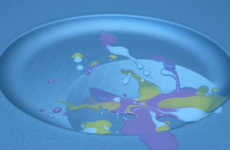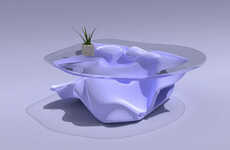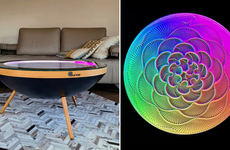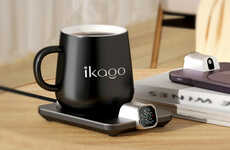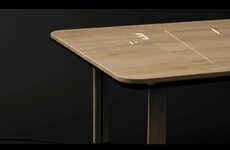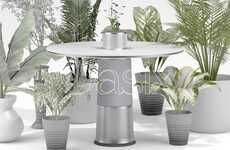
Huo Yijin's Teahouse Table Changes Color When Hot Water is Spilt
Meghan Young — October 17, 2011 — Art & Design
Huo Yijin's teahouse table was definitely made with clumsy individuals in mind. This interesting piece of furniture boasts a heat-sensitive surface that changes color every time hot water makes contact with it. Although Asian tea ceremonies are already considered an art form, Huo Yijin's teahouse table takes it to another technological level.
Huo Yijin's heat-sensitive table made its debut during Beijing Design Week. As part of a pop-up teahouse hosted by design retailer WUHAO in collaboration with socially responsible tea company Tranquil Tuesdays, it made quite the spectacle as its naturally brown surface changed to green with every spill of hot water. Canals engraved into Huo Yijin's table conveniently funnelled the excess spilt water into disposal containers beneath it, ensuring that nothing was wasted.
Huo Yijin's heat-sensitive table made its debut during Beijing Design Week. As part of a pop-up teahouse hosted by design retailer WUHAO in collaboration with socially responsible tea company Tranquil Tuesdays, it made quite the spectacle as its naturally brown surface changed to green with every spill of hot water. Canals engraved into Huo Yijin's table conveniently funnelled the excess spilt water into disposal containers beneath it, ensuring that nothing was wasted.
Trend Themes
1. Heat-sensitive Surfaces - Opportunity to create furniture and household items with heat-sensitive surfaces that change colors and can enhance the overall experience.
2. Interactive Household Items - Creating household items that are interactive like Huo Yijin's teahouse table that provides a new and unique experience for its users.
3. Sustainable Design Collaboration - Collaborating with socially responsible companies to create sustainable design that also brings innovative tech to everyday items.
Industry Implications
1. Furniture Manufacturing - Incorporating heat-sensitive surfaces and interactive design to furniture could disrupt the industry by providing a new and unique experience for consumers.
2. Home Goods Retail - Retailers could offer interactive household items, like Huo Yijin's teahouse table that changes color when hot water is spilt, to add to their product line and set themselves apart from competitors.
3. Sustainable Product Design - Socially responsible companies could work with designers to create sustainable household items with unique features like heat-sensitive surfaces that cater to the eco-conscious market.
2.8
Score
Popularity
Activity
Freshness


